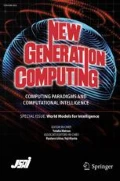Abstract
This paper investigates the application of evolutionary multi-objective optimization to two-dimensional procedural texture synthesis. Genetic programming is used to evolve procedural texture formulae. Earlier work used multiple feature tests during fitness evaluation to rate how closely a candidate texture matches visual characteristics of a target texture image. These feature test scores were combined into an overall fitness score using a weighted sum. This paper improves this research by replacing the weighted sum with a Pareto ranking scheme, which preserves the independence of feature tests during fitness evaluation. Three experiments were performed: a pure Pareto ranking scheme, and two Pareto experiments enhanced with parameterless population divergence strategies. One divergence strategy is similar to that used by the NSGA-II system, and scores individuals using their nearest-neighbour distance in feature-space. The other strategy uses a normalized, ranked abstraction of nearest neighbour distance. A result of this work is that acceptable textures can be evolved much more efficiently and with less user intervention with MOP evolution than compared to the weighted sum approach. Although the final acceptability of a texture is ultimately a subjective decision of the user, the proposed use of multi-objective evolution is useful for generating for the user a diverse assortment of possibilities that reflect the important features of interest.
Similar content being viewed by others
References
Coello, C. A. C., Van Veldhuizen, D. A. and Lamont, G. B.,Evolutionary Algorithms for Solving Multi-Objective Problems, Kluwer Academic Publishers, 2002.
Deb, K., Agrawa, S., Pratap, A. and Meyarivan, T., “A Fast Elitist Nondominated Sorting Genetic Algorithm for Multi-objective Optimization: NSGA-II,” inProc. PPSN VI, pp. 849–858, Springer-Verlag, 2000.
Ebert, D. S., Musgrave, F. K., Peachey, D., Perlin, K. and Worley, S.,Texturing and Modeling: a Procedural Approach, 2 ed., Academic Press, 1998.
Fonseca, C. M. and Fleming, P. J., “An Overview of Evolutionary Algorithms in Multiobjective Optimization,”Evolutionary Computation, 3, 1, pp. 1–16, 1995.
Goldberg, D. E.,Genetic Algorithms in Search, Optimization, and Machine Learning, Addison Wesley, 1989.
Holland, J. H.,Adaptation in Notural and Artificial Systems, MIT Press, 1992.
Horn, J., Nafpliotis, N. and Goldberg, D. E., “A Niched Pareto Genetic Algorithm for Multiobjective Optimization,” inProc. ICEC’94, pp. 82–87, 1994.
Ibrahim, A. E. M., “GenShade: an Evolutionary Approach to Automatic and Interactive Procedural Texture Generation,” Ph.D. thesis, Texas A & M University, Dec. 1998.
Koza, J. R.,Genetic Programming: On the Programming of Computers by Means of Natural Selection, MIT Press, 1992.
Laumanss, M., Zitzler, E. and Thiele, L., “On the Effects of Archiving, Elitism, and Density Based Selection in Evolutionary Multi-objective Optimization,” inProc. 1st Int. Conf. on Evolutionary Multi-Criterion Optimization, pp. 181–196, Springer-Verlag, 2001.
Lu, H. and Yen, G. G., “Rank-Density Based Multiobjective Genetic Algorithm,” inProc. CEC 2002, pp. 941–949, 2002.
Purshouse, R. C. and Fleming, P. J., “Elitism, Sharing, and Ranking Choices in Evolutionary Multi-Criterion Optimisation,”Technical Report 815, Dept. of Automatic Control and Systems Engineering, University of Sheffield, Jan. 2002.
Rooke, S., “Eons of Genetically Evolved Algorithmic Images,” in Bentley, P. J. and Corne, D. W. (eds.),Creative Evolutionary Systems, Morgan Kaufmann, pp. 330–365, 2002.
Rowe, J., Vinsen, K. and Marvin, N., “Parallel GAs for Multiobjective Functions,” inProc. of the 2nd Nordic Workshop on Genetic Algorithms and their Applications (2NWGA), pp. 61–70, University of Vaasa, Finland, 1996.
Sims, K., “Interactive Evolution of Equations for Procedural Models,”The Visual Computer, 9, pp. 466–476, 1993.
Smith, J. R., “Integrated Spatial and Feature Image Systems: Retrieval, Analysis and Compression,” Ph.D. thesis, Center for Telecommunications Research, Graduate School of Arts and Sciences, Columbia University, 1997.
Stollnitz, E., Derose, T. and Salesin, D.,Wavelets for Computer Graphics: Theory and Application, Morgan Kaufmann, 1996.
Upstill, S.,The Renderman Companion: A Programmer’s Guide to Realistic Computer Graphics, Addison-Wesley, 1989.
Veldhuizen, D. A. van and Lamont, G. B., “Multiobjective Evolutionary Algorithms: Analyzing the State-of-the-Art,”Evolutionary Computation, 8, 2, pp. 125–147, 2000,
Watt, A. and Watt, M.,Advanced Animation and Rendering Techniques: Theory and Practice, ACM Press, 1992.
Wiens, A. L. and Ross, B. J., “Gentropy: Evolutionary 2D Texture Generation,”Computers and Graphics Journal, 26, 1, pp. 75–88, Feb. 2002.
Zongker, D. and Punch, B.,lil-gp 1.0. User’s Manual, Dept. of Computer Science, Michigan State University, 1995.
Author information
Authors and Affiliations
Additional information
Brian J. Ross, Ph.D.: He is a professor of computer science at Brock University, where he has worked since 1992. He obtained his B.C.Sc. at the University of Manitoba, Canada in 1984, his M.Sc. at the University of British Columbia, Canada in 1988 and his Ph.D. at the University of Edinburgh, Scotland in 1992. His research interests include evolutionary computation, machine learning, language induction, concurrency, computer graphics, computer music and logic programming.
Han Zhu, M.Sc.: She is a programmer analyst at Total System Service Company, where she has worked since 2003. She obtained her B.Sc. at Brock University, Canada, in 2002, her M.Sc. at the University of Western Ontario, Canada, in 2003.
About this article
Cite this article
Ross, B.J., Zhu, H. Procedural texture evolution using multi-objective optimization. New Gener Comput 22, 271–293 (2004). https://doi.org/10.1007/BF03040964
Received:
Revised:
Issue Date:
DOI: https://doi.org/10.1007/BF03040964




